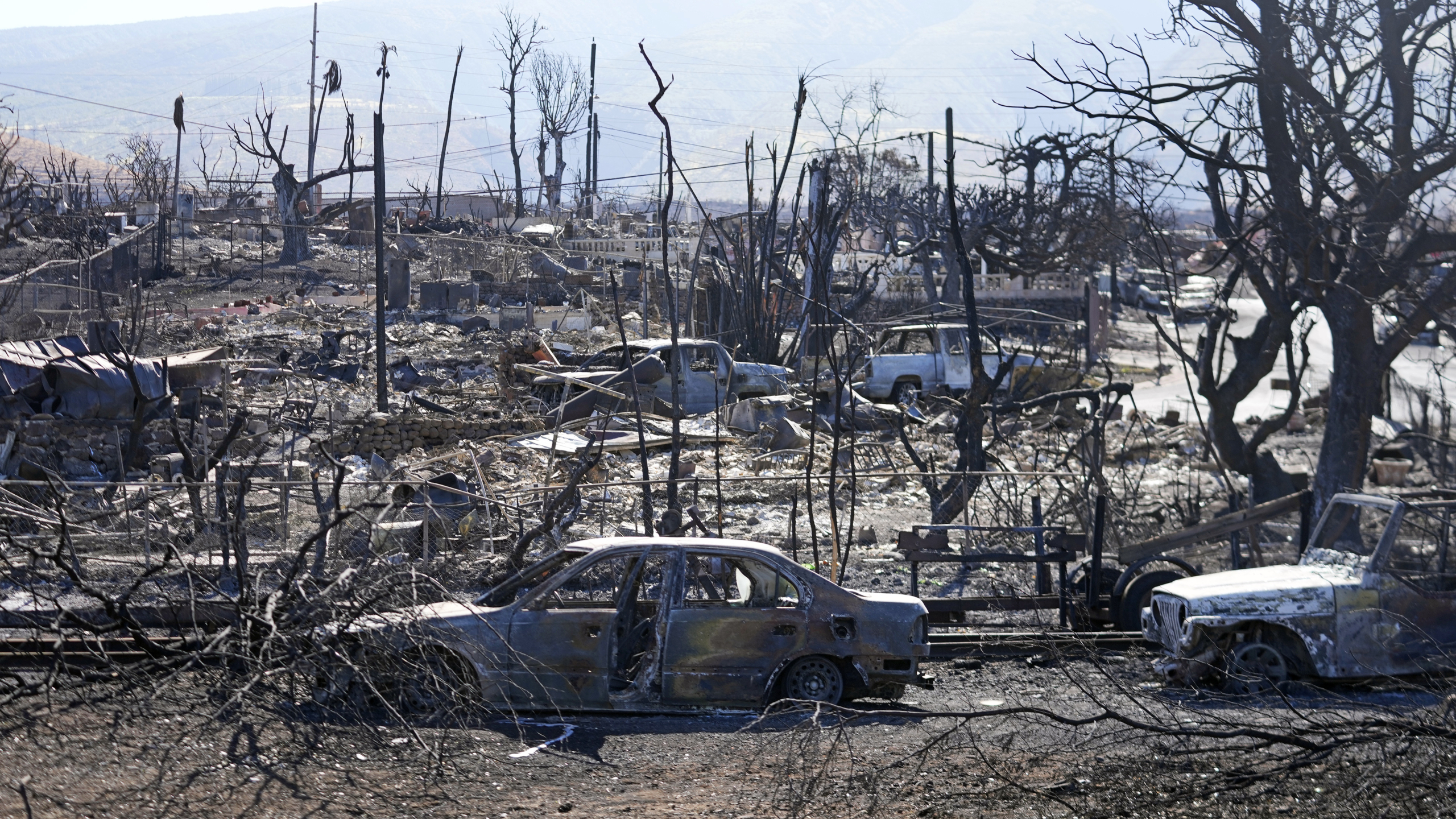Sign up for the daily CJR newsletter.
Six. Fifty-five. Sixty-seven. Eighty-nine. Ninety-three. Ninety-six. Since the middle of last week, cascading headlines have updated the confirmed death toll caused by wildfires in Hawai‘i. On Wednesday, the fires, whipped by winds from a passing hurricane, were officially the state’s deadliest natural disaster since a tsunami in 1960; by Saturday, they had become the deadliest wildfires nationally in more than a hundred years. The climate crisis exacerbated the devastation, as Hawai‘i has grown much drier in recent years. In the days to come, the confirmed death toll is only expected to rise.
As with the 2018 fires around Paradise, California, and myriad other extreme weather events since, the recent coverage of Hawai‘i has contained familiar flaws. The fires have been a huge national story, but they haven’t penetrated to the same extent everywhere, with political media particularly culpable. Over the weekend, Politico’s influential Playbook newsletter offered more in-depth coverage of a different state—Iowa—as Republican presidential candidates grilled meat at the State Fair ahead of caucuses that are still five months away; yesterday, several agenda-setting Sunday shows gave more airtime to the special-counsel investigation into Hunter Biden, the president’s son. (Meet the Press featured twenty-two mentions of “Hunter” and two of “Hawai‘i.”) And even when the fires have been the top story, coverage has not consistently situated them in the context of climate change. Evlondo Cooper, a researcher at Media Matters for America, assessed two hundred and nine segments about the fires on six major networks across two days last week. Just 4 percent of them mentioned climate change.
Coverage of the fires also pointed to dynamics that are specific to Hawai‘i, and which call to mind an article that Alexandria Neason—my former CJR colleague, who used to live in the state—wrote for our Climate Issue in 2020. “I have come to view the American presence on the island as a pyramid of destruction,” Neason wrote, with the US military at the base and capitalism—not least of the tourist variety—as the central block. “At the top of the pyramid,” Neason continued, “is the climate crisis, seen in the form of eroding coasts, furious storms, and endangered plants and animals—the same problems found around the world, in places that are the least responsible for disturbing their environment, places that have been taken over by outsiders.” This past week, we’ve seen it in the form of fire, too.
In researching her piece, Neason collected a litany of articles from national publications that purported to address how the climate crisis affected Hawai‘i through the prism of tourism. (From the Christian Science Monitor: “How climate change could ruin your Hawaii vacation.”) Since last week—when wildfires sparked on the islands of Hawai‘i (also known as “Big Island”) and Maui, where reporting has since been concentrated—that has been by no means the only lens through which national outlets have covered the devastation; indeed, some have amplified official calls not to come to Maui, and interviewed locals who have condemned tourists’ behavior in recent days. (One source told the BBC: “The same waters that our people just died in three days ago are the same waters the very next day these visitors—tourists—were swimming in.”) Still, coverage framed around tourists’ needs has, at the very least, formed its own subgenre. (“As deadly wildfires blaze, what’s the plan for hopeful Hawaii tourists right now?”)
The tendency to focus on tourism has been particularly pronounced in coverage of Lāhainā, a historic town on Maui that has been leveled by the fires. Kaniela Ing, an indigenous Hawaiian and national director of the Green New Deal Network, noted to Emily Atkin, who writes the climate newsletter Heated, that most breaking-news stories about the fires described Lāhainā as a tourist destination—“If you’re not from Maui and your readers are not from Maui, they probably only relate to it that way,” he said—and yet the town “was the heart of Hawaii before statehood, before we were a territory, before we were illegally annexed.” In a weekend column, Lee Cataluna, a Maui-born columnist for Honolulu Civil Beat, concurred that “much of the journalism that has come out of Lahaina in the days since the fire is for people outside of Lahaina.” Residents, after all, are busy grieving and hunting for logistical information, if they have internet access at all. “Any news story, any action, any opinion that doesn’t center the real people of Lahaina is tangential, maybe even superfluous,” Cataluna continued. “The people of Lahaina are what’s important.”
Some coverage has centered Hawaiians and their immediate needs, not least that of local journalists—who, in some cases, have had to contend with losing their own homes to the flames. A challenge for national outlets will be to sustain attention on the ground as the painstaking work of rebuilding begins; various outlets have reported that locals fear being shut out of that process by developers, second-home owners, and other moneyed interests. “What I am wondering, personally, is, once the recovery efforts start to unfold and the cameras are gone, who’s going to be left more powerful or less powerful?” Ing asked on Democracy Now! last week. “Are people still going to be paying attention when the recovery work is going to last for years? And is that going to make community members stronger, or is it going to make the people who have mismanaged the land and water and created the conditions for these fires to happen even more powerful?”
In his interview with Atkin, Ing noted that the climate crisis isn’t the only dynamic to have exacerbated the fires on Maui. The legacy of the island’s sugar plantations has factored in, too, disturbing natural water patterns (“Sugar,” Neason wrote in her CJR piece, “requires enormous amounts of water, and so it was diverted from Hawaiian farms and fishponds, displacing their proprietors”) and accelerating the spread of nonnative, highly flammable varieties of grass. “On one hand, the climate emergency caused this,” Ing said. “On the other, it’s also that history of colonial greed that made Lahaina the dry place that it is.” Some national coverage of the fires has explained the role of foreign settlers and the big business of (literally) sowing seeds that helped the devastation spread. But if coverage linking the fires to the climate crisis has been spotty, coverage explicitly grappling with the colonial legacy of Hawai‘i has been even more so.
As I’ve seen it, even otherwise insightful national-level coverage of the fires has often started from the premise, at least implicitly, that they are spoiling a pristine island paradise—a narrative that itself has roots in the colonial past, as Neason observed. Ikaika Hussey, a labor organizer, told Neason that “there’s a Hawai‘i that exists in people’s imagination,” one invented by “guys at Disney, at the marketing departments in Waikīkī, and journalists.” Now, as then, we should ask ourselves the question that Hussey posed to Neason: “Who is Hawai‘i for?” And we should remember, as Neason did in response, that while “climate change puts everyone at risk,” the question “of how to confront the crisis will be a matter of whose story is at the forefront, whose survival is deemed the most important.”
Other notable stories:
- On Friday, police in Marion, Kansas, raided the offices of the Marion County Record, a local newspaper, and the home of Eric Meyer, its editor and publisher, seizing electronic devices and reporting materials. The next day, Joan Meyer—Eric’s mother, who co-owned the paper and was ninety-eight—died; the County Record said that the raid had left her “stressed beyond her limits and overwhelmed by hours of shock and grief.” The raid appeared to stem from the paper obtaining records that revealed a local businessperson’s drunk-driving conviction—but the paper was also, at the time, investigating allegations of misconduct against the local police chief. National news organizations and press-freedom groups excoriated the raid as a flagrant violation of the First Amendment.
- Also on Friday, Fox Corporation announced the departure of Viet Dinh, its powerful chief legal officer. Dinh’s role at the company had come into question following its massive recent payout to Dominion Voting Systems, an election-tech company that sued Fox News for defamation over its coverage of Donald Trump’s lies about the 2020 election. Dinh reportedly expressed confidence that Fox would win on First Amendment grounds, but the network wound up settling following a series of embarrassing disclosures linked to the case. Dinh will remain an adviser to Fox. Jeremy W. Peters has more for the New York Times (and Ben Smith profiled Dinh for the same paper back in 2021).
- Neeraj Khemlani, the copresident of CBS News, is also leaving his job, with the network confirming his departure yesterday after the news leaked to the New York Post. Alexandra Steigrad writes that Khemlani’s “two-year cost-cutting reign was marked by clashes with high-profile anchors and HR complaints”; just last month, Steigrad reported that HR was monitoring Khemlani following allegations of “bullying” behavior. Khemlani told staff yesterday that he will stay at CBS in a different role, one that has yet to be announced but will, he said, have a greater focus on reporting.
- Louise Delmotte, of the Associated Press, was able to capture several images of Jimmy Lai, the former publisher of Apple Daily, a pro-democracy newspaper in Hong Kong, who was jailed amid a clampdown on press freedom. Lai had not been photographed since 2021 and spends most of his time in solitary confinement, but Delmotte snapped photos showing him walking in a prison enclosure, holding a book and looking thinner than he did before. (ICYMI, Hsiuwen Liu wrote about Hong Kong’s press for our recent issue.)
- And, with the two-year anniversary of the fall of Kabul set to take place tomorrow, the Committee to Protect Journalists called on the Taliban to end its record of intimidating journalists in Afghanistan, noting that the country’s “once vibrant free press is a ghost of its former self.” (Also in our recent issue, Emily Russell explored the fate of US efforts to export democracy to Afghanistan via the media. You can listen to her piece here.)
ICYMI: The disarray and discontent at Forbes
Has America ever needed a media defender more than now? Help us by joining CJR today.







